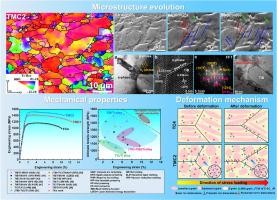钛基复合材料中间隙元素与TiB的协同作用克服强度-延性权衡
IF 14.3
1区 材料科学
Q1 MATERIALS SCIENCE, MULTIDISCIPLINARY
引用次数: 0
摘要
高强度钛基复合材料存在固有的强度-延性权衡问题,限制了其广泛应用。本研究通过粉末冶金的方法,对Ti-6Al-4V基复合材料进行了间隙C、N和TiB的协同强化,获得了超高的抗拉强度(1510±5 MPa)和良好的延伸率(8.7%±0.3%)。原位形成的TiB促进了基体晶粒的等轴化,阻碍了晶粒的生长,并为动态再结晶的晶粒提供了大量的形核位点。通过评价间隙C和N在Ti- 6al - 4v基体中的分布及其对TiB/Ti界面稳定性的影响,第一性原理计算结果表明,C和N倾向于占据α-Ti中的八面体间隙位置,从而引起晶格畸变,显著提高(001)TiB/(0001)α-Ti界面强度。此外,拉伸试验下的准原位电子背散射衍射揭示了间隙C和N对复合材料变形机制的影响。间隙C和N促进了复合材料中<; C +a>;位错的活化,增加了锥体<; C +a>;滑移体系的比例。同时激活多个滑移体系是提高复合材料延性的主要因素。本文的实验和理论计算结果为在不牺牲延性的情况下设计和制造超高强度钛基复合材料提供了新的思路。本文章由计算机程序翻译,如有差异,请以英文原文为准。

Synergistic effects of interstitial elements and TiB to overcome strength-ductility trade-off in titanium matrix composites
High-strength titanium matrix composites commonly show an inherent strength-ductility trade-off dilemma, which restricts their wide-range applications. Herein, we achieved synergistic strengthening of Ti-6Al-4V matrix composites by interstitial C, N, and TiB via powder metallurgy and obtained ultra-high tensile strength (1510±5 MPa) and good elongation (8.7%±0.3%). In situ-formed TiB promotes equiaxialization of matrix grains, hinders grain growth, and provides numerous nucleation sites for dynamically recrystallized grains. By evaluating the distribution of interstitial C and N in the Ti-6Al-4V matrix and their effect on the stability of the TiB/Ti interface, first-principles calculation results demonstrated that C and N tend to occupy the octahedral interstitial positions in α-Ti, thus inducing lattice distortion and significantly enhancing the (001)TiB/(0001)α-Ti interfacial strength. In addition, quasi-in-situ electron backscatter diffraction under tensile tests revealed the influences of interstitial C and N on the deformation mechanism of the composites. Interstitial C and N promote the activation of <c+a> dislocations in composites and increase the proportion of pyramidal <c+a> slip systems. The simultaneous activation of multiple slip systems is the primary factor in improving the composite’s ductility. Experimental and theoretical calculation results in this work provide a new strategy for designing and fabricating ultra-high-strength titanium matrix composites without sacrificing their ductility.
求助全文
通过发布文献求助,成功后即可免费获取论文全文。
去求助
来源期刊

Journal of Materials Science & Technology
工程技术-材料科学:综合
CiteScore
20.00
自引率
11.00%
发文量
995
审稿时长
13 days
期刊介绍:
Journal of Materials Science & Technology strives to promote global collaboration in the field of materials science and technology. It primarily publishes original research papers, invited review articles, letters, research notes, and summaries of scientific achievements. The journal covers a wide range of materials science and technology topics, including metallic materials, inorganic nonmetallic materials, and composite materials.
 求助内容:
求助内容: 应助结果提醒方式:
应助结果提醒方式:


